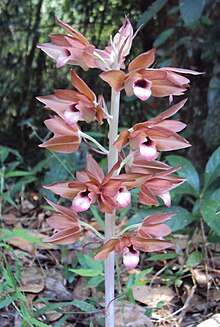Eulophia zollingeri
| Carrion orchid | |
|---|---|

| |
| Eulophia zollingeri near Kottiyoor, India | |
| Scientific classification | |
| Kingdom: | Plantae |
| Clade: | Tracheophytes |
| Clade: | Angiosperms |
| Clade: | Monocots |
| Order: | Asparagales |
| Family: | Orchidaceae |
| Subfamily: | Epidendroideae |
| Genus: | Eulophia |
| Species: | E. zollingeri
|
| Binomial name | |
| Eulophia zollingeri | |
| Synonyms[1] | |
|
List
| |
Eulophila zollingeri, commonly known as the carrion orchid[2] or 无叶美冠兰 (wu ye mei guan lan),[3] is a plant in the orchid family and is native to areas from tropical and subtropical Asia to Queensland. It is a leafless, brownish terrestrial orchid with up to forty reddish brown, sharply scented flowers with a dark red and yellow labellum. It grows in decaying wood in and near rainforests.
It is classified as a partial mycoheterotroph that maintains a specialized symbiotic relationship with the wood decaying fungi Psathyrellaceae throughout all life stages. Isotopic analysis and chlorophyll data have shown that the orchid also performs its own photosynthesis during the fruiting stage. Its leafless underground habit is typical of saprophytic orchids but it also can perform photosynthesis in its stems.[4]
Description
Eulophia zollingeri is a terrestrial herb with an underground pseudobulb. It has no green leaves but fleshy, pointed bracts on the flowering stem. Between six and forty reddish brown flowers 40–50 mm (1.6–2.0 in) long and 50–60 mm (2.0–2.4 in) wide are borne on a flowering stem 400–900 mm (20–40 in) tall. The flowers have a sharp, unpleasant odour. The dorsal sepal is elliptic to oblong in shape, 15–23 mm (0.6–0.9 in) long, 4–7 mm (0.2–0.3 in) wide and curves forward. The lateral sepals are more or less oblong in shape, 16–25 mm (0.6–1 in) long, 6–9 mm (0.2–0.4 in) wide and have a pointed tip. The petals are lance-shaped, 11–18 mm (0.4–0.7 in) long, 5–7 mm (0.2–0.3 in) wide. The labellum is dark red, yellow on the outside, oblong to egg-shaped, 14–15 mm (0.55–0.59 in) long, 15–18 mm (0.6–0.7 in) wide and has three lobes. The middle lobe curves downward and has short, thick hairs whilst the side lobes are erect. Flowering occurs between December and February in Australia and from April to May in China[2][3][5]
Taxonomy and naming
The carrion orchid was first formally described in 1857 by Heinrich Gustav Reichenbach who gave it the name Cyrtopera zollingeri and published the description in Bonplandia.[6][7] In 1905, Johannes Jacobus Smith changed the name to Eulophia zollingeri.[8]
Distribution and habitat
Eulophia zollingeri grows in and near the edges of rainforest where there is rotting wood. It occurs in China, Taiwan, India, Indonesia, Japan, Malaysia, New Guinea, the Philippines, Sri Lanka, Thailand, Vietnam and tropical northern Queensland.[2][3]
References
- ^ a b "Eulophia zollingeri". Plants of the World Online. Retrieved 18 April 2024.
- ^ a b c Jones, David L. (2006). A complete guide to native orchids of Australia including the island territories. Frenchs Forest, N.S.W.: New Holland. p. 359. ISBN 1877069124.
- ^ a b c "Eulophia zollingeri". Flora of China. Retrieved 27 October 2018.
- ^ Suetsugu, Kenji; Ohta, Tamihisa; Tayasu, Ichiro (2024). "Partial mycoheterotrophy in the leafless orchid Eulophia zollingeri specialized on wood-decaying fungi". Mycorrhiza. 34 (1–2): 33–44. doi:10.1007/s00572-024-01136-w. ISSN 0940-6360.
- ^ D.L.Jones; T.Hopley; S.M.Duffy (2010). "Factsheet - Eulophia zollingeri". Australian Tropical Rainforest Orchids. Centre for Australian National Biodiversity Research (CANBR), Australian Government. Retrieved 30 May 2021.
- ^ "Cyrtopera zollingeri". APNI. Retrieved 27 October 2018.
- ^ Reichenbach, Heinrich Gustav (1857). "Orchideae Zollingerianae itineris primi recensentur". Bonplandia. 5: 38–39. Retrieved 27 October 2018.
- ^ "Eulophia zollingeri". APNI. Retrieved 27 October 2018.
